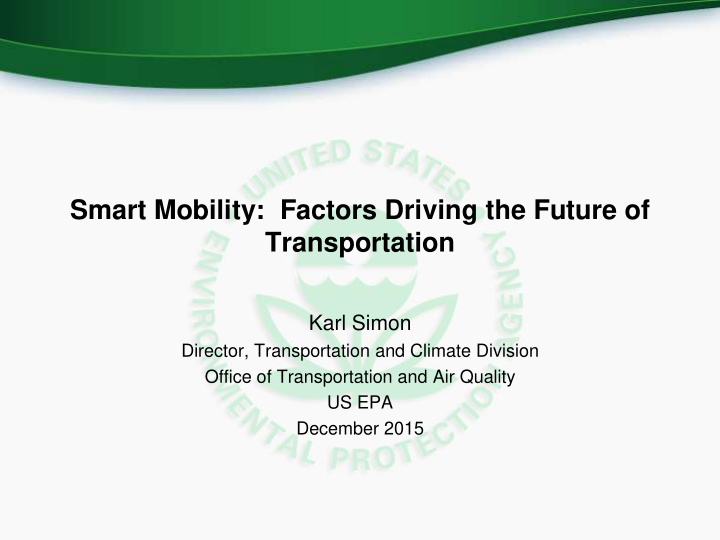



Smart Mobility: Factors Driving the Future of Transportation Karl Simon Director, Transportation and Climate Division Office of Transportation and Air Quality US EPA December 2015
The Challenge
Carbon Budget
Source: Jari Kauppila Global freight will more than quadruple Senior Economist, Head of Outlook and Statistics, OECD by 2050 (by a factor of 4.3) Smart Freight Leadership, Leipzig, 26 May 2015
Population and Urbanization We will create the equivalent of one new city of one million people every 5 days between now and 2050 --International Geosphere- Biosphere Programme UN: World Urbanization Prospects 2014 UNEP: Keeping Track of our Changing Environment 2011
Even with our GHG Rules We’re Light Duty GHG Emissions Headed Here But We Need To Go 2025 2030 2035 2040 2045 2050 Here
Light Duty Vehicles U.S. GHG/Fuel Economy standards provide significant benefits to climate, oil, consumers 500 450 GHG Emissions (grams/mile) 400 350 Midterm 300 Evaluation 250 200 163 g/mi CO 2 150 54.5 mpg ( if all reductions 100 from fuel 1975 1980 1985 1990 1995 2000 2005 2010 2015 2020 2025 2030 economy) Model Year 9
Light Duty Vehicles GHG Compliance … Good News So Far 305 300 11 g/mile 295 Lower than 290 GHG (grams/mile) Standard 12 g/mile Compliance 285 Lower than Target Standard 280 275 Standard 270 265 260 255 250 2012 2013 Model Year 10
Light Duty Vehicles MY 2015 Fleet Volume That Meets MY 2020 Standards Vehicles are meeting future standards with a variety of technologies Trucks SUVs Cars Nissan Rouge Honda CR-V Honda Civic Ford F-150 Ford Focus Ram 1500 Renegade Silverado Outback Mazda 6 Hyundai Subaru Sonata Chevy Jeep SFE HF Diesel X Turbocharging X X X X High Compression Atkinson X Engine GDI X X X X X X Cylinder Deactivation X Stop-start X Transmissi 8+ Speed Transmissions X *compared to MY2008 on CVT X X X X curb weight ** Top 25% of class + Mass Reduction* X X X Road other Tires** X X X X X X active/passive 11 Loads features Aero** X X X X X
Light Duty Vehicles Midterm Evaluation – Overview • Technical review of longer term Energy Environment standards for 2022-2025 Technology Consumers • In coordination with NHTSA and CARB Factors • EPA’s decision could go one of 3 ways: Infrastructure Market Standards remain same More stringent Less stringent Economics 12
Heavy Duty Trucks Freight has fastest-growing transportation GHGs in US and globally worldwide o Worldwide, freight projected to outstrip passenger vehicle GHG emissions within several decades o Rapid demographic, geo- economic and technical change will disrupt freight patterns in US and globally o United States and EPA must lead ExxonMobil 2013 Energy Outlook Report 13
Heavy Duty Trucks 1200 1100 Phase 1 Reduction GHG (MMT CO 2 eq) 1000 Phase 2 Proposal 900 Reduction 800 700 600 Calendar Year
Heavy Duty Trucks Federal Phase 2 Proposed Standards The Phase 2 program builds on the success of Phase 1, with similar design and vehicle categories – and, for the first time, including fuel efficiency standards for trailers 65% of HD Fuel Consumption and GHG Inventory (together) Vocational Vehicles Trailers Pulled by Large Pickups & Vans 21% of HD Fuel Combination Tractors Consumption and GHG 14% of HD Fuel Consumption Combination Inventory and GHG Inventory Tractors (currently unregulated Federally) Heavy-Duty Standards in g/mile and gallons/100 miles Standards in g/ton-mile and gallons/1000 ton-miles Standards in g/ton-mile and gallons/1000 ton-miles
Aircraft Aircraft GHG Emissions Contribution U.S. Contributions • 11% of U.S. transportation GHGs • Largest remaining transportation category not yet regulated for GHGs • 3% of total U.S. GHG contributions Global Contributions • 2% today, but future growth is very high • If ranked as a nation, would be 9 th , just behind Germany • U.S. aircraft GHG emissions are ~7 times higher than China’s GHG emissions (second ranked country for aircraft GHG emissions & fastest growing) 1 INTERNAL DELIBERATIVE MATERIAL – DO NOT CITE OR QUOTE 6
Renewable Fuels
It is not just about GHGs
Technology alone will not save us 21
The Promise
The Reality
Today’s Cars • 80% empty • 95% stationary • 99% owned
Parking or Parks? Red= Surface Parking Yellow=parking garage Green=Parks
IPCC AR4 Category I reduction envelope BAU Scenario
Transformational Change is Possible 28
Vehicle Efficiency Fuels and Vehicle Electrification Connectivity CAVs and the Environment Built Personal Environment Connectivity
autonomous Private Autonomy Shared Autonomy private shared owner driver Today Shared Mobility human
Some combination of CAVs these factors can lead to: Equitable access to mobility Shared Clean Vehicles Mobility Space for people, not cars Slowing the rate of climate change
We cannot solve our problems with the same thinking we used when we created them . A LBERT E INSTEIN We need to rethink the mobility paradigm
“There is such a thing as being too late when it comes to climate change.” - President Obama, August 3, 2015 36
Recommend
More recommend